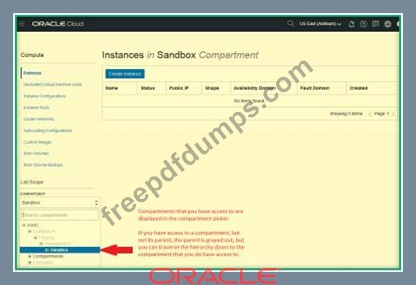Compartments are the primary building blocks you use to organize your cloud resources. You use compartments to organize and isolate your resources to make it easier to manage and secure access to them. When your tenancy is provisioned, a root compartment is created for you. Your root compartment holds all of your cloud resources. You can think of the root compartment like a root folder in a file system. The first time you sign in to the Console and select a service, you will see your one, root compartment.

You can create compartments under your root compartment to organize your cloud resources in a way that aligns with your resource management goals. As you create compartments, you control access to them by creating policies that specify what actions groups of users can take on the resources in those compartments. Keep in mind the following when you start working with compartments: At the time you create a resource (for example, instance, block storage volume, VCN, subnet), you must decide in which compartment to put it. Compartments are logical, not physical, so related resource components can be placed in different compartments. For example, your cloud network subnets with access to an internet gateway can be secured in a separate compartment from other subnets in the same cloud network. You can create a hierarchy of compartments up to six compartments deep under the tenancy (root compartment). When you write a policy rule to grant a group of users access to a resource, you always specify the compartment to apply the access rule to. So if you choose to distribute resources across compartments, remember that you will need to provide the appropriate permissions for each compartment for users that will need access to those resources. In the Console, compartments behave like a filter for viewing resources. When you select a compartment, you only see resources that are in the compartment selected. To view resources in another compartment, you must first select that compartment. You can use the Search feature to get a list of resources across multiple compartments.
See Overview of Search. You can use the compartment explorer to get a complete view of all the resources (across regions) that reside in a specific compartment. See Viewing All Resources in a Compartment. If you want to delete a compartment, you must delete all resources in the compartment first. Finally, when planning for compartments you should consider how you want usage and auditing data aggregated.
Reference:
https://docs.cloud.oracle.com/en-us/iaas/Content/GSG/Concepts/settinguptenancy.htm#Understa


